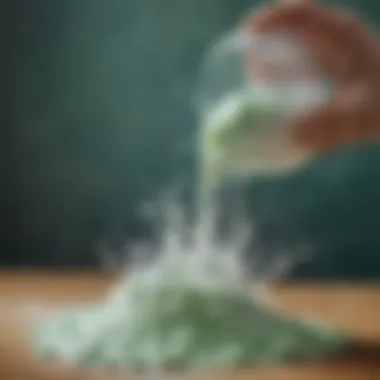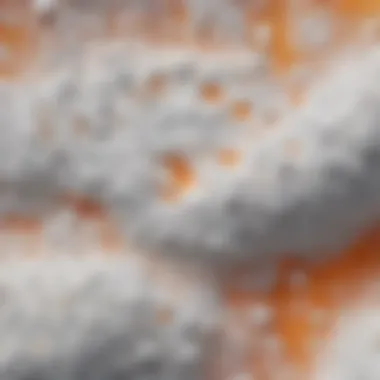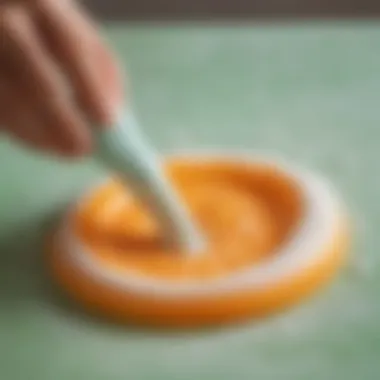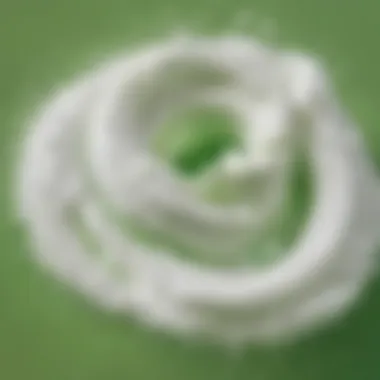Unveiling the Impact of Baking Soda in Slime Creation: An In-Depth Analysis


Science Fun Facts
In the realm of slime creation, there exists an intriguing interplay between baking soda and other ingredients. Did you know that the chemical reaction between baking soda and activators like contact lens solution or borax is what gives slime its unique texture and stretchiness? Understanding the scientific principles behind this process can open doors to endless experimentation and discovery.
Discover the Wonders of Science
By exploring the role of baking soda in slime-making, we embark on a journey into the realm of chemistry and material science. Through educational resources such as videos, animations, and interactive tools, we can unravel the mysteries of polymer formation and bonding mechanisms. This exploration not only enhances our understanding of slime but also introduces us to broader scientific concepts that shape the world around us.
Science Experiment Showcase
Engaging in hands-on experiments that involve baking soda and slime ingredients can be a thrilling learning experience for children. To conduct a successful experiment, gather the necessary materials: glue, baking soda, activator, and any desired add-ins like glitter or food coloring. Remember to follow safety precautions by wearing gloves and working in a well-ventilated area. Step-by-step instructions can guide you through the process, leading to the creation of customizable slime with varying textures and characteristics.
Introduction
In the realm of scientific exploration, delving into the role of baking soda in slime creation unveils a captivating journey into chemical reactions and material transformations. This article aims to dissect the intricate dance between baking soda and slime ingredients, shedding light on how this seemingly humble compound wields significant influence over the final product's texture and properties. By unraveling the mysteries of baking soda's impact on slime, we pave the way for a deeper understanding of this peculiar concoction's behavior.
Defining Slime
Slime, in its essence, is a non-Newtonian fluid characterized by its unique viscosity and moldable nature. Unlike traditional liquids, slime exhibits shear-thinning properties, meaning it becomes less viscous under stress. Its intriguing consistency allows for various shapes and forms, captivating the curious minds of both children and adults. By defining slime within the scientific context, we set the stage for a detailed exploration of its intricate chemistry and behavior.


The Popularity of Slime Making
The surge in popularity of slime making transcends mere recreation, delving into the realms of sensory play and tactile exploration. With its mesmerizing textures and endless creative possibilities, slime has captured the attention of individuals seeking both relaxation and stimulation. The tactile satisfaction offered by slime has led to its widespread use in educational settings and stress-relief practices. Understanding the appeal of slime making provides valuable insights into its evolving role in modern play and therapeutic applications.
Understanding Baking Soda
Baking soda, also known as sodium bicarbonate, plays a crucial role in the process of slime making. It is essential to comprehend the significance of baking soda within the context of this scientific investigation, as it directly influences the chemical reactions that occur during slime formation. By understanding the properties and functions of baking soda, we can gain valuable insights into how it interacts with other ingredients to produce varying textures and qualities in slime.
Chemical Properties of Baking Soda
An in-depth exploration of the chemical properties of baking soda reveals its alkaline nature and its ability to act as a p H buffer. When dissolved in water, baking soda releases bicarbonate ions that can react with acidic components present in slime recipes, leading to the formation of carbon dioxide bubbles. This reaction not only contributes to the characteristic fizziness in some slime variations but also influences its overall texture and consistency.
Function of Baking Soda in Reactions
The function of baking soda in slime-making reactions is multifaceted. As an alkaline compound, baking soda acts as an activator in conjunction with other ingredients like glue and saline solution. The bicarbonate ions released by baking soda interact with the polyvinyl acetate molecules in glue, causing them to crosslink and form a polymer network. This network structure is critical for giving slime its unique stretchy and moldable properties, enhancing its tactile appeal and play value for children and enthusiasts alike.
The Science Behind Slime Formation
Slime formation is a captivating process in the realm of chemistry and creativity, holding significant importance in this scientific investigation. Understanding the intricate science behind slime formation allows us to delve into the fascinating interactions between different ingredients that culminate in this stretchy, slimy substance. By exploring the chemical reactions and bonding mechanisms involved in slime making, we can unravel the mysteries of its unique properties and textures, paving the way for exciting experiments and discoveries.


The Role of Activator in Slime
The activator plays a crucial role in slime formation, acting as the catalyst that initiates the binding process between the ingredients. It serves to activate the cross-linking of molecules, enabling them to form the characteristic slime structure. Without the activator, the ingredients would remain separate and fail to achieve the desired consistency and elasticity. By understanding the function of the activator, we gain insight into how different elements interact to create the final slime product, guiding us in optimizing the slime-making process for the best results.
Interaction of Baking Soda with Other Ingredients
Baking soda, a key ingredient in slime making, interacts dynamically with other components to influence the overall texture and properties of the slime. Its chemical properties allow it to react with specific elements in the slime mixture, altering the viscosity and stretchiness of the final product. By observing how baking soda interacts with glue, water, and other ingredients, we can grasp the intricacies of these chemical reactions and their impact on slime consistency. This section explores the intricate dance between baking soda and other elements, shedding light on the underlying mechanisms of slime formation.
Effects of Baking Soda Concentration on Slime Texture
The concentration of baking soda in a slime recipe directly affects the texture and viscosity of the resulting slime. By varying the amount of baking soda used, we can observe how changes in concentration impact the stretchiness, pliability, and overall feel of the slime. Understanding the effects of baking soda concentration empowers slime makers to customize their recipes and achieve their desired slime consistency. This section delves into the nuances of adjusting baking soda levels in slime making, offering insights into how concentration influences the sensory experience of playing with slime.
Experimental Insights
In this section of our scientific exploration into the role of baking soda in slime making, we enter the realm of experimental insights. Here, we will uncover the significance of conducting experiments to understand how varying amounts of baking soda impact the final slime product. Delving deep into the world of chemical reactions and substance interactions, experimental insights play a crucial role in unraveling the mysteries of slime creation. By meticulously manipulating baking soda concentrations, we aim to decipher how this fundamental ingredient influences slime texture and properties, offering a glimpse into the intricate scientific processes at play.
Conducting Slime Experiments with Varying Baking Soda Amounts
When delving into exploring the role of baking soda in slime making, conducting experiments with varying amounts of this key ingredient becomes paramount. By carefully adjusting the levels of baking soda in slime formulations, researchers can observe how these changes affect the consistency, stretchiness, and overall quality of the slime. Through meticulous measurement and controlled testing, the scientific community gains valuable insights into the intricate relationship between baking soda concentrations and slime behavior. These experiments serve as the foundation for understanding the complexities of chemical interactions within slime mixtures and pave the way for fine-tuning slime recipes to perfection.


Observations and Findings
As we embark on a journey through our slime experiments with varying baking soda amounts, intriguing observations and findings come to light. Through keen observation and systematic data collection, we uncover how increasing or decreasing baking soda levels impact the slime's texture, viscosity, and overall sensory experience. These empirical findings provide concrete evidence of the direct correlation between baking soda concentrations and slime properties, shedding light on the intricate mechanisms underlying slime formation. By meticulously documenting our observations and analyzing the results, we gain valuable insights that not only enhance our scientific understanding but also pave the way for optimizing slime recipes for an unparalleled sensory delight.
Practical Applications
In the realm of slime making, practical applications involving baking soda play a crucial role in achieving the desired consistency and properties of the final product. Throughout this article, the significance of understanding and mastering these applications will become apparent as we dissect the intricate interactions between baking soda and other slime ingredients. By delving into practical applications, readers will not only grasp the theoretical aspects but also gain invaluable insights into the hands-on aspects of slime creation, making this a well-rounded exploration of the subject matter.
Tips for Achieving Desired Slime Consistency Using Baking Soda
Achieving the perfect slime consistency using baking soda requires precision and attention to detail. One key tip is to start with small amounts of baking soda and gradually increase the quantity to avoid overactivating the slime. Stirring the mixture thoroughly and ensuring uniform distribution of baking soda is essential for creating a smooth and stretchy texture. Moreover, experimenting with different proportions of baking soda can yield varying results, allowing for customization based on individual preferences. By following these tips, readers can master the art of using baking soda effectively to control the consistency of their slime creations.
Creative Ways to Experiment with Baking Soda in Slime Making
For those seeking to elevate their slime-making experience, experimenting with baking soda opens up a world of creative possibilities. Incorporating scents or colors into the baking soda can add an olfactory or visual dimension to the slime. Additionally, adjusting the amount of baking soda can alter the slime's texture, ranging from fluffy and airy to dense and compact. Mixing baking soda with different activators, such as contact lens solution or saline solution, can create unique chemical reactions that result in diverse slime outcomes. By encouraging readers to think outside the box and innovate with baking soda, this section aims to inspire creativity and exploration in the realm of slime making.
Conclusion
In concluding this meticulous exploration of the role of baking soda in slime-making, it becomes evident that understanding the nuances of this seemingly simple ingredient is crucial for achieving desired slime consistency and properties. The significance of acknowledging how baking soda interacts with other slime components goes beyond mere experimentation; it paves the way for innovative slime creations that captivate both young scholars and inquisitive minds. By grasping the complexities of baking soda's role in slime formation, enthusiasts can elevate their slime-making experience to a scientific endeavor, fostering curiosity and analytical thinking.
Summary of Key Findings
Through rigorous experimentation and observation, several key findings emerged regarding the influence of baking soda on slime texture and properties. Noteworthy discoveries include the precise relationship between baking soda concentration and slime consistency, as well as its role as an activator in the slime-making process. These insights offer a deeper understanding of how baking soda impacts slime, empowering creators to fine-tune their recipes and customize their slime-making adventures according to their preferences and desired outcomes.
Significance of Understanding Baking Soda's Role in Slime
The significance of comprehending baking soda's role in slime extends beyond mere hobbyist interest. By delving into the scientific principles governing the interaction between baking soda and other slime ingredients, enthusiasts are poised to unlock a world of possibilities within the realm of slime-making. Understanding how baking soda influences slime texture, consistency, and overall properties not only enhances the creativity and experimentation involved but also fosters a deep appreciation for the chemical processes at play. This knowledge empowers individuals to approach slime-making as a thoughtful and educational pursuit, blending science and creativity in a uniquely engaging way.







